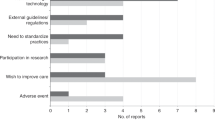Abstract
Objective
To identify key features in the NICU care delivery context that influence quality of care delivery.
Study design
Qualitative study using in-depth, semi-structured interviews with 10 NICU quality experts with extensive experience conducting NICU site visits and evaluating quality of care. Analyses were performed using the method of constant comparison based on grounded theory.
Results
Qualitative analysis yielded three major themes: (1) the foundation for high quality care is a cohesive unit culture, characterized by open communication, teamwork, and engagement of families; (2) effective linkages between measurement and improvement action is necessary for continuous improvement; and (3) NICU capacity for improvement is sustained by active support, exchange of skills, and resources from the hospital.
Conclusions
Team cohesion, engagement of families, culture of improvement supported by measurement and institutional support from the hospital are some of the key contextual and managerial features critical to high-quality NICU care.
This is a preview of subscription content, access via your institution
Access options
Subscribe to this journal
Receive 12 print issues and online access
$259.00 per year
only $21.58 per issue
Buy this article
- Purchase on Springer Link
- Instant access to full article PDF
Prices may be subject to local taxes which are calculated during checkout

Similar content being viewed by others
References
Profit J, Zupancic JA, Gould JB, Pietz K, Kowalkowski MA, Draper D, et al. Correlation of neonatal intensive care unit performance across multiple measures of quality of care. JAMA Pediatr. 2013;167:47–54.
Horbar JD, Edwards EM, Greenberg LT, Morrow KA, Soll RF, Buus-Frank ME, et al. Variation in performance of neonatal intensive care units in the United States. JAMA Pediatr. 2017;171:e164396.
Rogowski JA, Staiger DO, Horbar JD. Variations in the quality of care for very-low-birthweight infants: implications for policy. Health Aff. 2004;23:88–97.
Profit J, Gould JB, Bennett M, Goldstein BA, Draper D, Phibbs CS, et al. The association of level of care with NICU quality. Pediatrics. 2016;137:e20144210.
Lorch SA. A decade of improvement in neonatal intensive care: how do we continue the momentum? JAMA Pediatr. 2017;171:e164395.
Chassin MR, Galvin RW. The urgent need to improve health care quality. Institute of Medicine National Roundtable on Health Care Quality. JAMA. 1998;280:1000–5.
Vachharajani A, Vachharajani N, Morris H, Niesen A, Elward A, Linck D, et al. Reducing peripherally inserted central catheters in the neonatal intensive care unit. J Perinatol. 2017;37:409–13.
Walsh M, Laptook A, Kazzi SN, Engle WA, Yao Q, Rasmussen M, et al. A cluster-randomized trial of benchmarking and multimodal quality improvement to improve rates of survival free of bronchopulmonary dysplasia for infants with birth weights of less than 1250 grams. Pediatrics. 2007;119:876–90.
Ovretveit J. Understanding the conditions for improvement: research to discover which context influences affect improvement success. BMJ Qual Saf. 2011;20(Suppl 1):i18–23.
Goetsch DL, Davis SB. Quality management for organizational excellence: introduction to total quality. New Jersey: Pearson; 2014.
Ahire SL, Landeros R, Golhar DY. Total quality management: a literature review and an agenda for future research. Prod Oper Manag. 1995;4:277–306.
Sousa R, Voss CA. Quality management re-visited: a reflective review and agenda for future research. J Oper Manag. 2002;20:91–109.
Zu X, Fredendall LD, Douglas TJ. The evolving theory of quality management: the role of Six Sigma. J Oper Manag. 2008;26:630–50.
Monden Y. Toyota production system: practical approach to production management. Industrial Engineering and Management Press, Institute of Industrial Engineers; Norcross, GA, 1983.
Berwick DM. Continuous improvement as an ideal in health care. N Engl J Med. 1989;320:53–6.
Shortell SM, Bennett CL, Byck GR. Assessing the impact of continuous quality improvement on clinical practice: what it will take to accelerate progress. Milbank Q. 1998;76:593–624.
Kaplan HC, Provost LP, Froehle CM, Margolis PA. The Model for Understanding Success in Quality (MUSIQ): building a theory of context in healthcare quality improvement. BMJ Qual Saf. 2012;21:13–20.
Kaplan HC, Brady PW, Dritz MC, Hooper DK, Linam WM, Froehle CM, et al. The influence of context on quality improvement success in health care: a systematic review of the literature. Milbank Q. 2010;88:500–59.
Profit J, Etchegaray J, Petersen LA, Sexton JB, Hysong SJ, Mei M, et al. Neonatal intensive care unit safety culture varies widely. Arch Dis Child Fetal Neonatal Ed. 2012;97:F120–6.
Profit J, Sharek PJ, Kan P, Rigdon J, Desai M, Nisbet CC, et al. Teamwork in the NICU setting and its association with health care-associated infections in very low-birth-weight infants. Am J Perinatol. 2017;34:1032–40.
Deming WE. Out of crisis. Cambridge: Massachusetts Institute of Technology, Center for Advanced Engineering Study; 1986.
Glaser B, Strauss A. The discovery of grounded theory: strategies for qualitative research. Chicago: Aldine; 1967.
Miles MB, Huberman AM. Qualitative data analysis: an expanded sourcebook. 2nd ed. Thousand Oaks: Sage Publications; 1994.
Profit J, Soll RF. Neonatal networks: clinical research and quality improvement. Semin Fetal Neonatal Med. 2015;20:410–5.
Pronovost PJ, Berenholtz SM, Goeschel C, Thom I, Watson SR, Holzmueller CG, et al. Improving patient safety in intensive care units in Michigan. J Crit Care. 2008;23:207–21.
Thomas EJ, Williams AL, Reichman EF, Lasky RE, Crandell S, Taggart WR. Team training in the neonatal resuscitation program for interns: teamwork and quality of resuscitations. Pediatrics. 2010;125:539–46.
Salas E, Rosen MA. Building high reliability teams: progress and some reflections on teamwork training. BMJ Qual Saf. 2013;22:369–73.
Powell TC. Total quality management as competitive advantage: a review and empirical study. Strateg Manag J. 1995;16:15–37.
Walshe K, Freeman T. Effectiveness of quality improvement: learning from evaluations. Qual Saf Health Care. 2002;11:85–7.
Mills PD, Weeks WB. Characteristics of successful quality improvement teams: lessons from five collaborative projects in the VHA. Jt Comm J Qual Saf. 2004;30:152–162.
Nelson EC, Batalden PB, Huber TP, Mohr JJ, Godfrey MM, Headrick LA, et al. Microsystems in health care: part 1. Learning from high-performing front-line clinical units. Jt Comm J Qual Improv. 2002;28:472–93.
Bodenheimer T, Ghorob A, Willard-Grace R, Grumbach K. The 10 building blocks of high-performing primary care. Ann Fam Med. 2014;12:166–71.
California Perinatal Quality Care Collaborative. Quality improvement context tool. Accessed date 14 February 2018. https://www.cpqcc.org/QI-context-tool.
Grooms HR, Froehle CM, Provost LP, Handyside J, Kaplan HC. Improving the context supporting quality improvement in a neonatal intensive care unit quality collaborative: an exploratory field study. Am J Med Qual. 2017;32:313–21.
Acknowledgements
We are grateful to the following individuals for contributing their time and expertise to this study: Lisa Bollman; David Braun; Doug Cunningham; Allen Fischer; David Perrott; Cecele Quaintance; Aida Simonian.
Author information
Authors and Affiliations
Corresponding author
Ethics declarations
Conflict of interest
The authors declare that they have no conflict of interest.
Electronic supplementary material
Rights and permissions
About this article
Cite this article
Dhurjati, R., Wahid, N., Sigurdson, K. et al. Never judge a book by its cover: how NICU evaluators reach conclusions about quality of care. J Perinatol 38, 751–758 (2018). https://doi.org/10.1038/s41372-018-0092-0
Received:
Revised:
Accepted:
Published:
Issue Date:
DOI: https://doi.org/10.1038/s41372-018-0092-0



